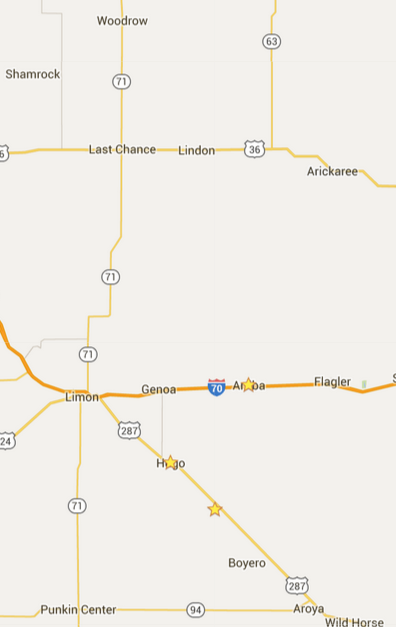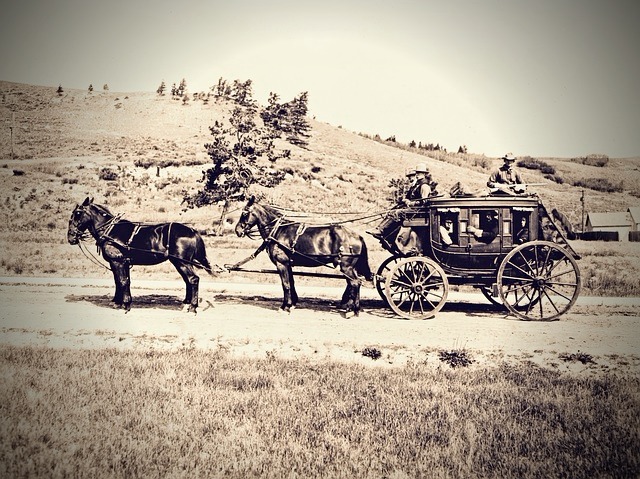Along the Ghost Trails
On a clear day, one can sit on the grasslands and watch the ghosts of wagon trains pass on the waves of the prairie mirage. Numerous trails crossed Lincoln County, brought the gold and fortune seekers west. There were the stage routes, freight roads, military routes and wagon roads. SH 63 follows along the eastern edge of Lincoln County and crosses most of these phantom trails. SH 63 is a north south state route and a well maintained gravel country road. It has it curves and dog legs yet it is an adventure awaiting the traveler.
At the north end of the 
county,the state road crosses the Arickaree River. Paralleling the Arickaree was the Benkelman cutoff ofthe Smoky Hill Trail. Today the Arickaree doesn’t look like any more than a dry sand creek. Over a century ago it was a small river carrying water to join the Republican River. Following this trail, early travelers were assured of a good water supply. It was still in use into the 1930’s. A few of the old timers can remember seeing a few people traveling and they also can point out where a few ruts remain from this obscure trail.
Further south on SH 63 at the Jct. with I-70 is the town of Arriba, the town of two cities and a forlorn mansion.
Traveling on south on Hwy 63 one crosses the Leavenworth and Pikes Peak stage route and freight trail. CR 2Z goes east for a bit, paralleling the old stage road. Some place through here is where a stage station had been. Most people say the stage station was south on SH63 at an old abandoned house. When one looks at the creek that parallels CR2Z through this area, there are numerous springs and a few trees. Each of these areas would make a nice stage station. Where Station 22 was located is not definitive, makes for some myths.
Here one can pause and visualize the long freight trains rolling up the hill. Many of these freight trains would number over 100 wagons and many doubled up, pulled with 3-6 yoke of oxen. There were riders herding the extra oxen and relief drivers for ones that got sick. The stages would gallop along this trail, headed for Denver. The stages would travel in pairs to help protect from Indian attacks. It is along this route that Horace Greeley traveled when he first came west. There were stories of numerous Indian attacks and run away stages that Greeley’s traveling companion recounted.
 Traveling on south on SH 63 one comes to a dog leg. In this area and on south a number of miles stretched the Texas Montana Cattle trail. The massive cattle herds from Texas passed this area on their way north. To the north is the town of Bovina, it was named for the cattle herds that paused in the area. Some of these herds could number as many as 9000 head of cattle. As they traveled north they were always in search of water for the cattle. Sometimes the trail could be 15 miles wide, depending where water was.
Traveling on south on SH 63 one comes to a dog leg. In this area and on south a number of miles stretched the Texas Montana Cattle trail. The massive cattle herds from Texas passed this area on their way north. To the north is the town of Bovina, it was named for the cattle herds that paused in the area. Some of these herds could number as many as 9000 head of cattle. As they traveled north they were always in search of water for the cattle. Sometimes the trail could be 15 miles wide, depending where water was.

Driving on south on SH 63 one climbs over a divide between the Republican River and the Arkansas basin. On this ridge one can see out over the Big Sandy valley. With some keen eyes, the ghosts of the covered wagons or cattle herds can be seen moving over the mirage waves of the prairie.
Just before the junction with CR 2R on the north side, the North Branch of the Smokey Hill Trail crosses SH 63. It was also used by the Butterfield Overland Dispatch and Wells Fargo stage lines. Looking down the hill a ways can be seen a windmill. In this area would have been Hugo Springs, a stop on the stage line. The pioneer road went straight across the land to join with the South Branch of the Smoky Hill Trail east of Hugo.
To the northeast of the Lady Bird, on US Hwy. 40 rest area is another stage stop, Coon Springs. There are some trees in the area and occasionally ponds in the creek. To the south was Mirage, a stop on the south branch. Here there is a live stream and a grove of trees.
Many of the old stage stations were difficult to pinpoint because of their construction and short lives. The early stations were built in 1860 and closed a few years later. The railroad eliminated the stage lines through the area when the rails were completed in the mid 1870’s. Most of the stations were built of adobe or dugouts into the hillside. The corrals were sometimes referred to as mule cellars, being built into the hillside or dug outs. There were tunnels connecting the corrals and other structures because of the numerous Indian attacks. Some of the stations built small forts. A small hole was dug and then thatched with twigs, grasses and mud. Small slits were in the adobe blocks for gun ports and there was a water barrel in this dug out pit. It was connected to the house by a tunnel.
The remains of these structures have disappeared over time. Being on private property, the stations are not easy to access. A few locals have been able to take metal detectors and search some of the areas, with permission. They have found spent rifle cartridges and metal buttons in the area where the stations were suspected of being. The stage stations truly are ghosts floating over the plains.
Moving on south on SH 63 and crossing US Hwy. 40/287, one comes to the ghost town of Boyero. Boyero was a railroad town. It was the railroad that gave it life and it was the railroad that gave it ghosts. Boyero had been a fair sized community on the Golden Belt Route, until the highway was rerouted. There are a few buildings still standing and some hardy residents that keep the ghosts company. Some streets are still visible and the roadway follows along the railroad tracks. Here there was also a stage stop on the South Branch of the Smoky Hill Trail.
The Kansas Pacific Railroad made Boyero a major stop along their line. With the nearby stage line stop, there were numerous Indian attacks in the area, on the stage stations and the railroad workers.
Today it is the whirlwinds that stir up the dust. A few cattle graze nearby, the buffalo are gone but there are deer and bald eagles in the woods of the Big Sandy. Here one can catch glimpses of numerous birds, the darting merlin, the soaring prairie falcon, chirping meadow larks, gimp winged killdeer or the darting swallows or flycatchers.
